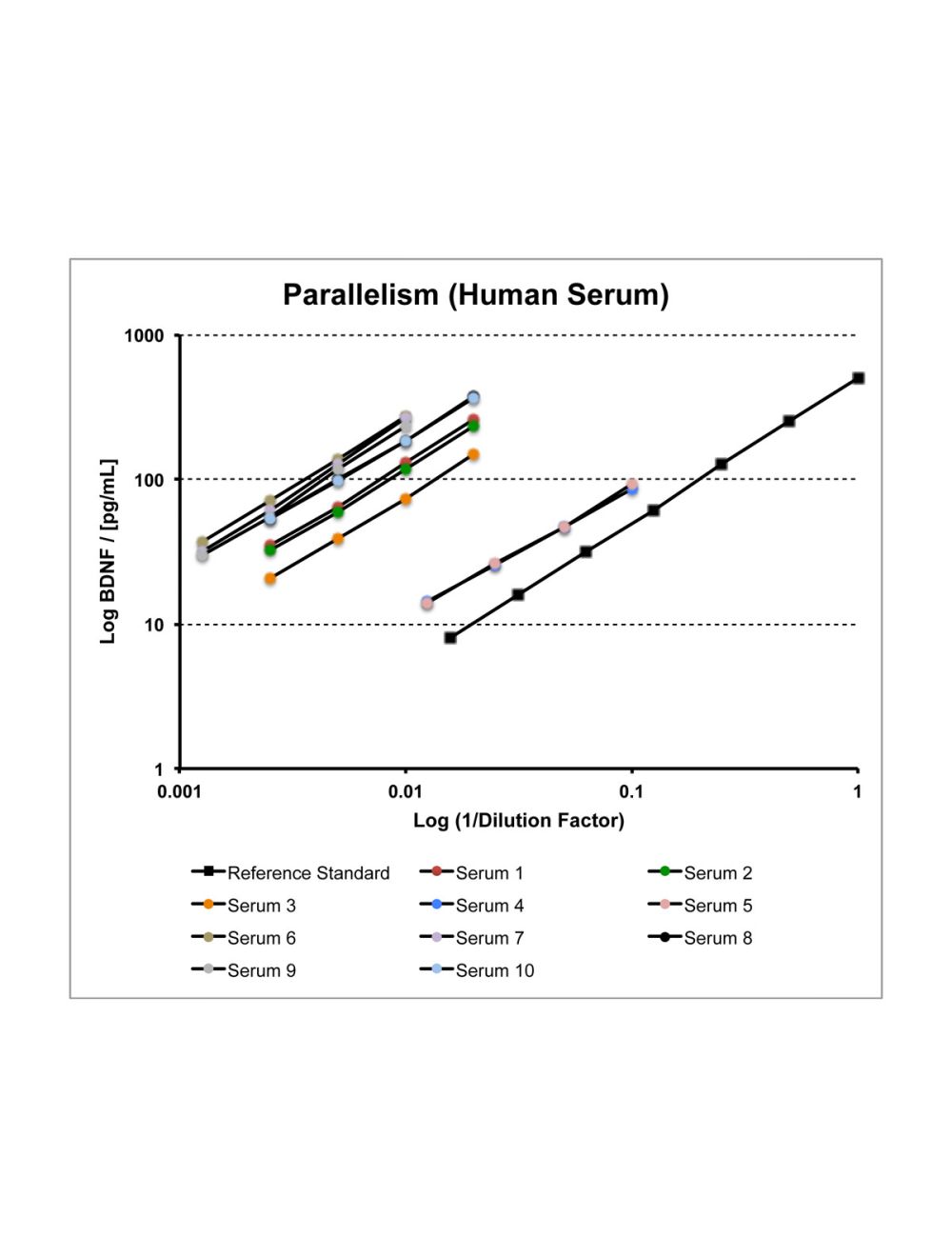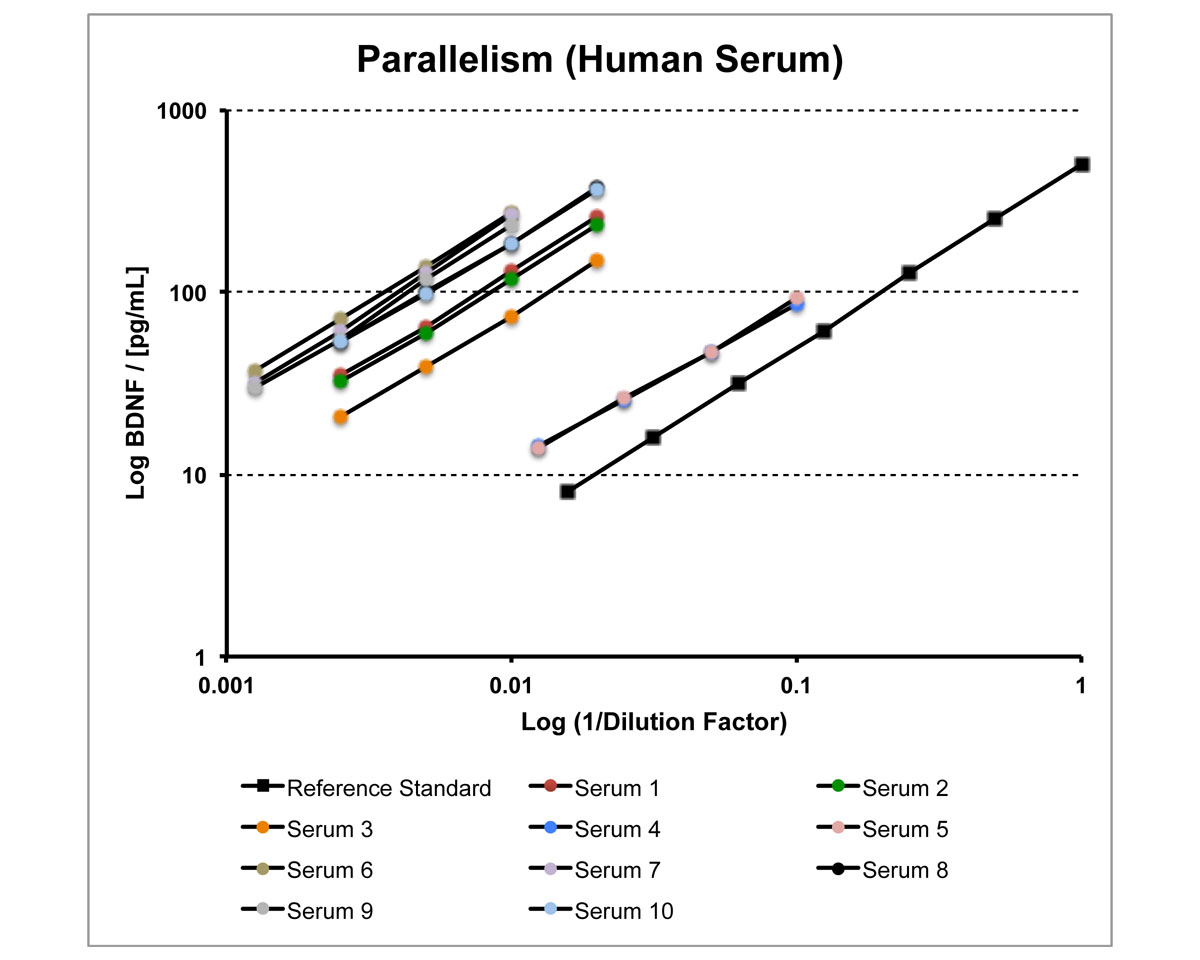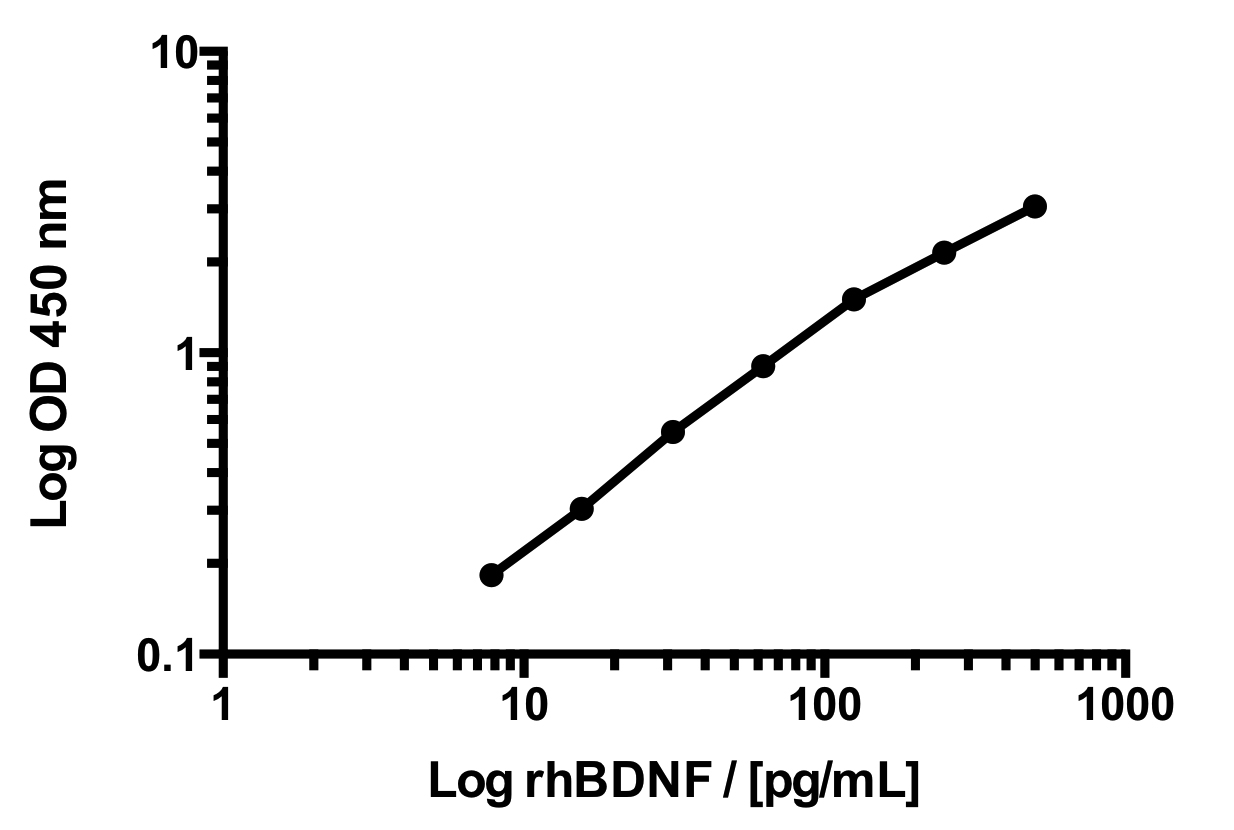Brain-derived neurotrophic factor, mature (BDNF, mature), Human, Mouse, Rat, Rapid™ ELISA assay
- Product Name Brain-derived neurotrophic factor, mature (BDNF, mature), Human, Mouse, Rat, Rapid™ ELISA assay
-
Product Description
The Biosensis Mature BDNF RapidTM enzyme-linked immunosorbent assay (ELISA) Kit is a sandwich ELISA that allows the quantification of mature BDNF in less than 3 hours in cell culture supernatants, serum, plasma (citrate and EDTA), pig serum, cell lysates, brain extracts, human milk and Sheep CSF only if used as directed, with a simplified protocol and no loss of sensitivity or specificity. Please refer to the kit protocol for specific use instructions for each substrate application, in particular blood samples, human milk and CSF. Note that accurate quantification of BDNF in human milk requires a secretory IgA (sIgA) blocker which can be purchased separately (BL-001-1250). For measurement of mature BDNF in CSF samples, please contact us at [email protected].
This ELISA kit has been tested in independent research laboratories and found to achieve highest reproducibility with intra- and inter-assay CVs as low as 1% and 5%, respectively (Polacchini et al., 2015).
This ELISA kit consists of a pre-coated mouse monoclonal anti-mature BDNF capture antibody, a biotinylated anti-mature BDNF detection antibody and horseradish peroxidase (HRP)-conjugated streptavidin. The addition of a substrate (3,3',5,5'-tetramethylbenzidine, TMB) yields a coloured reaction product which is directly proportional to the concentration of mature BDNF present in samples and protein standards. A BDNF positive control (QC sample) is provided to assure consistent assay performance.
This Mature BDNF ELISA kit employs a recombinant human mature BDNF standard approved by the World Health Organization (WHO, www.nibsc.org). The amino acid sequence of mature BDNF is identical for human, mouse, rat and a number of other species. This kit therefore is suitable to measure mature BDNF in all these species and uses the same antibodies and antigen.
Extensive validation has demonstrated that the Mature BDNF RapidTM ELISA shows only minimal cross-reactivity with proBDNF. Please refer to our Technical Note #5 for further details on ELISA assay validation for BDNF isoform detection and quanification.
This ELISA kit has not been tested for other applications. It has been configured for research use only and is not to be used for diagnostic or clinical procedures. For in-vitro diagnostic (IVD) applications in the European Economic Area (EEA), we refer to the CE Marked BDNF ELISA kit (BEK-2211-CE). - Alternative Names BDNF; Brain-derived neurotrophic factor; Abrineurin;
- Application(s) ELISA
- Species Reactivity Human, Mouse, Rat
- Immunogen Description Recombinant human BDNF with an N-terminal methionine residue, made in E. coli (WHO reference reagent)
- Range 7.8 pg/mL - 500 pg/mL
- Sensitivity Typical limit of detection (LOD) for BDNF is less than 2 pg/mL, determined as 150% of the blank value.
- Regulatory Status For research use only.
Product Info
-
Product Description
The Biosensis Mature BDNF RapidTM enzyme-linked immunosorbent assay (ELISA) Kit is a sandwich ELISA that allows the quantification of mature BDNF in less than 3 hours in cell culture supernatants, serum, plasma (citrate and EDTA), pig serum, cell lysates, brain extracts, human milk and Sheep CSF only if used as directed, with a simplified protocol and no loss of sensitivity or specificity. Please refer to the kit protocol for specific use instructions for each substrate application, in particular blood samples, human milk and CSF. Note that accurate quantification of BDNF in human milk requires a secretory IgA (sIgA) blocker which can be purchased separately (BL-001-1250). For measurement of mature BDNF in CSF samples, please contact us at [email protected].
This ELISA kit has been tested in independent research laboratories and found to achieve highest reproducibility with intra- and inter-assay CVs as low as 1% and 5%, respectively (Polacchini et al., 2015).
This ELISA kit consists of a pre-coated mouse monoclonal anti-mature BDNF capture antibody, a biotinylated anti-mature BDNF detection antibody and horseradish peroxidase (HRP)-conjugated streptavidin. The addition of a substrate (3,3',5,5'-tetramethylbenzidine, TMB) yields a coloured reaction product which is directly proportional to the concentration of mature BDNF present in samples and protein standards. A BDNF positive control (QC sample) is provided to assure consistent assay performance.
This Mature BDNF ELISA kit employs a recombinant human mature BDNF standard approved by the World Health Organization (WHO, www.nibsc.org). The amino acid sequence of mature BDNF is identical for human, mouse, rat and a number of other species. This kit therefore is suitable to measure mature BDNF in all these species and uses the same antibodies and antigen.
Extensive validation has demonstrated that the Mature BDNF RapidTM ELISA shows only minimal cross-reactivity with proBDNF. Please refer to our Technical Note #5 for further details on ELISA assay validation for BDNF isoform detection and quanification.
This ELISA kit has not been tested for other applications. It has been configured for research use only and is not to be used for diagnostic or clinical procedures. For in-vitro diagnostic (IVD) applications in the European Economic Area (EEA), we refer to the CE Marked BDNF ELISA kit (BEK-2211-CE). -
Related Products
Brain-derived neurotrophic factor, pro- (proBDNF), Human, Mouse, Rat, Rapid™ ELISA assay
Mature BDNF/proBDNF Combo (BEK-2211/2237), Human, Mouse, Rat, Rapid™ ELISA assay
Mature BDNF/proBDNF Combo (BEK-2211/2217), Human, Mouse, Rat, Rapid™ ELISA assay
Secretory IgA Blocker for BEK-2211 and similar ELISA assays
- Application(s) ELISA
- Application Details ELISA. For the quantification of Brain-derived neurotrophic factor, mature (BDNF, mature) in Culture Supernatant, Serum, Plasma (Citrate), Plasma (EDTA), Cell Lysates, Tissue Homogenates, Human Milk, CSF. Please download the detailed product insert for complete instructions for the successful use of this ELISA. Use only as directed.
- Target Brain-derived neurotrophic factor, mature (BDNF, mature)
- Target Cross-Reactivity (ELISA) No cross-reactivity is observed for nerve growth factor (NGF), neurotrophin-3 (NT-3), NT-4/5, glial cell line-derived neurotrophic factor (GDNF) and vascular endothelial growth factor (VEGF165) tested at 25 ng/mL in assay buffer. The reactivity of full-length proBDNF (0.125 ng/mL - 5 ng/mL) was determined in six independent assays using proBDNF proteins from four different sources (mammalian and bacterial, wild-type and mutated). The average cross-reactivity of proBDNF was found to be 5.3% +/- 0.5% in weight (w/v) concentration, or 12.1% +/- 1.2% in molar concentration (mean +/- SEM). Additional proBDNF cross-reactivity experiments were conducted as summarized in our Technical Note #5.
- Target Host Species Human
- Species Reactivity Human, Mouse, Rat
- Immunogen Description Recombinant human BDNF with an N-terminal methionine residue, made in E. coli (WHO reference reagent)
- Range 7.8 pg/mL - 500 pg/mL
- Sensitivity Typical limit of detection (LOD) for BDNF is less than 2 pg/mL, determined as 150% of the blank value.
- Sample Type Cell Lysates, CSF, Culture Supernatant, Human Milk, Plasma (Citrate), Plasma (EDTA), Serum, Tissue Homogenates
- Detection Method Colorimetric
- Kit Components The ELISA kit box contains 96-well pre-coated strip plate(s), protein standards, QC sample, detection reagents, wash and sample buffers, substrate buffer and detailed protocols.
- Storage Instructions Store at 2-8°C
- Storage Temperature 2-8°C
- Batch Number Please see item label.
- Expiration Date 12 months from purchase.
- Alternative Names BDNF; Brain-derived neurotrophic factor; Abrineurin;
- Uniprot Number P23560
- Uniprot Number/Name P23560 (BDNF_HUMAN)
- Scientific Background BDNF belongs to the neurotrophin family and regulates the survival and differentiation of neurons during development. The alterations in BDNF expression induced by various kinds of brain insult including stress, ischemia, seizure activity and hypoglycemia, may contribute to some pathologies such as depression, epilepsy, Alzheimer's, and Parkinson's disease. FUNCTION: Promotes the survival of neuronal populations that are all located either in the central nervous system or directly connected to it. Major regulator of synaptic transmission and plasticity at adult synapses in many regions of the CNS. The versatility of BDNF is emphasized by its contribution to a range of adaptive neuronal responses including long-term potentiation (LTP), long-term depression (LTD), certain forms of short-term synaptic plasticity, as well as homeostatic regulation of intrinsic neuronal excitability. SUBUNIT: Monomers and homodimers. Binds to NTRK2/TRKB. SUBCELLULAR LOCATION: Secreted protein. Post Translation Modification (PTM): The propeptide is N-glycosylated and glycosulfated. PTM: Converted into mature BDNF by plasmin (PLG) (By similarity). DISEASE: Defects in BDNF are a cause of congenital central hypoventilation syndrome (CCHS); also known as congenital failure of autonomic control or Ondine curse. CCHS is a rare disorder characterized by abnormal control of respiration in the absence of neuromuscular or lung disease, or an identifiable brain stem lesion. A deficiency in autonomic control of respiration results in inadequate or negligible ventilatory and arousal responses to hypercapnia and hypoxemia. CCHS is frequently complicated with neurocristopathies such as Hirschsprung disease that occurs in about 16% of CCHS cases. SIMILARITY: Belongs to the NGF-beta family.
- Shipping Statement For order quantities larger than 1 plate, this product is supplied in package units of 2 plates.
- Shipping Temperature 2-8°C (on cold packs)
- UNSPSC CODE 41116158
- Regulatory Status For research use only.
Specifications
-
Specific References
Total Number of References: 126
Latest References (2022-2024):
Dell’Oste V et al. (2024) Plasma and Platelet Brain-Derived Neurotrophic Factor (BDNF) Levels in Bipolar Disorder Patients with Post-Traumatic Stress Disorder (PTSD) or in a Major Depressive Episode Compared to Healthy Controls International Journal of Molecular Sciences 25(6):1-18 Application: Human Serum
Ha J et al. (2024) In patients with late-life depression and cognitive decline, adding tDCS to congnitive training does not significantly affect depressive symptoms but shows potential benefits on cognition as measured by fMRI 6th INTERNATIONAL BRAIN STIMULATION CONFERENCE Application: Human Serum
Palmisano B et al. (2024) A pathogenic role for brain derived neurotrophic factor (BDNF) in fibrous dysplasia of bone Bone. Ahead of Print Application: Mouse BloodKania K et al. (2024) Predicting clinical progression and cognitive decline in patients with relapsing-remitting multiple sclerosis: a 6-year follow-up study Neurol. Neurochir. Pol. Ahead of Print Application: Peripheral Blood
Chaney R et al. (2024) Cerebral Benefits Induced by Electrical Muscle Stimulation Evidence from a Human and Rat Study Int J Mol Sci. 25(3), 1883. Application: Rat, Serum
Unterholzner J et al. (2024) Effects of lockdowns on neurobiological and psychometric parameters in unipolar depression during the COVID-19 pandemic Transl Psychiatry. 14(1):42. Application: Human, Serum
Hardiany NS et al. (2024) Exploration of neuroprotective effect from Coriandrum sativum L. ethanolic seeds extracts on brain of obese rats Sci Rep.14(1):603. Application: Rat, Brain homogenate
Li Z et al. (2023) Blue light at night produces stress-evoked heightened aggression by enhancing brain-derived neurotrophic factor in the basolateral amygdala Neurobiol Stress. 28:100600. Application: Rat, Tissue homogenate
Su X et al. (2023) Decellularized extracellular matrix scaffold seeded with adipose-derived stem cells promotes neurorestoration and functional recovery after spinal cord injury through Wnt/ β-catenin signaling pathway regulation Biomed Mater. 19(1). Application: Rat, Tissue homogenate; Cell culture supernatant.
Varghese N et al. (2023) Interplay between stress, sleep, and BDNF in a high-risk sample of young adults Sci Rep. 13(1):20524. Application: Human, Serum.
Ng DQ et al. (2023) Brain-derived neurotrophic factor as a biomarker in cancer-related cognitive impairment among adolescent and young adult cancer patients Sci Rep. 13(1):16298 Application: Human, Plasma-EDTA
Reguilón MD et al. (2023) Voluntary wheel running during adolescence prevents the increase in ethanol intake induced by social defeat in male mice Psychopharmacology (Berl). [Epub ahead of print] Application: Mouse, Brain homogenate.
Marazziti D et al. (2023) Relationship between BDNF and oxytocin Psychoneuroendocrinology. [Epub ahead of print] Application: Human, Plasma-EDTA.
Modarresi S et al. (2023) Pain Informed Movement for people with knee osteoarthritis: Protocol for a pilot randomized controlled trial Osteoarthr Cartil Open. 5(4):100402. Application: Human, Serum.
Mallik SB et al. (2023) Involvement of indoleamine 2, 3-dioxygenase (IDO) and brain-derived neurotrophic factor (BDNF) in the neuroprotective mechanisms of ferulic acid against depressive-like behaviour Metab Brain Dis. [Epub ahead of print] Application: Mouse, Brain homogenate.
Falaschi V et al. (2023) Variation of Circulating Brain-Derived Neurotrophic Factor (BDNF) in Depression: Relationships with Inflammatory Indices, Metabolic Status and Patients’ Clinical Features Life. 13(7), 1555. Application: Human, Plasma -EDTA (platelet-poor plasma)
Higuchi Y et al. (2023) Serotonergic circuit dysregulation underlying autism-related phenotypes in BTBR mouse model of autism Neuropharmacology. 237:109634. Application: Mouse, Brain tissue homogenate.
Covarrubias C et al. (2023) Decrease in the Ratio proBDNF/BDNF in the Urine of Aging Female Patients with OAB Metabolites. 13(6), 723. Application: Human, Urine.
Cremone IM et al. (2023) Unlocking the Secrets: Exploring the Biochemical Correlates of Suicidal Thoughts and Behaviors in Adults with Autism Spectrum Conditions Biomedicines. 11(6), 1600. Application: Human, Platelet rich plasma; platelet poor plasma; serum; platelet pellets.
Granitzer S et al. (2023) BDNF and KISS-1 Levels in Maternal Serum, Umbilical Cord, and Placenta: The Potential Role of Maternal Levels as Effect Biomarker Expos. Health. [Epub ahead of print]. Application: Human, Serum; Cell culture supernatant.
Eitan E et al. (2023) Synaptic proteins in neuron-derived extracellular vesicles as biomarkers for Alzheimer’s disease: novel methodology and clinical proof of concept Extracell Vesicles Circ Nucleic Acids. 4:133-50. Application: Human, neuron-derived extracellular vesicles lysates.
Ishikura T et al. (2023) Olfactory Regeneration with Nasally Administered Murine Adipose-Derived Stem Cells in Olfactory Epithelium Damaged Mice Cells. 12(5), 765 Application: Mouse, cell culture supernatant
Roszkowicz-Ostrowska K et al. (2022) Central Stimulatory Effect of Kynurenic Acid on BDNF-TrkB Signaling and BER Enzymatic Activity in the Hippocampal CA1 Field in Sheep Int J Mol Sci. 24(1):136 Application: Sheep, Brain tissue homogenate.
Yu T et al. (2022) Multisession Anodal Transcranial Direct Current Stimulation Enhances Adult Hippocampal Neurogenesis and Context Discrimination in Mice J. Neurosci. 10.1523 Application: Mouse, Brain tissue homogenate.
Jaehne EJ et al. (2022) Chronic running-wheel exercise from adolescence leads to increased anxiety and depression-like phenotypes in adulthood in rats: Effects on stress markers and interaction with BDNF Val66Met genotype Dev. Psychobiol. [Epub ahead of print] Application: Rat, tissue lysates.
Baliyan S et al. (2022) Milk fat globule membrane concentrate as a nutritional supplement prevents age-related cognitive decline in old rats: A lipidomic study of synaptosomes Int. Food Res. J. [Epub ahead of print] Application: Rat, brain tissue homogenate.
Ron E et al. (2022) Association of plasma brain-derived neurotrophic factor levels and frailty in community-dwelling older adults Sci Rep. 12(1):18605 Application: Human, plasma.
Meshkat S et al. (2022) Brain-Derived Neurotrophic Factor (BDNF) as a biomarker of treatment response in patients with Treatment Resistant Depression (TRD): A systematic review & meta-analysis Psychiatry Res. 317:114857 Application: Human, serum.
Cook A et al. (2022) Activation of TrkB-Akt signaling rescues deficits in a mouse model of SCA6 Sci Adv. [Epub ahead of print] Application: Mouse, brain extracts.
Tsotsoros CE et al. (2022) Pilot Associations between Adverse Childhood Experiences, Executive Function, and Brain-Derived Neurotrophic Factor (BDNF) among Adults with Excess Adiposity Obesities. 2, 276-284. Application: Human, serum.
Salem HA et al. (2022) Neuroprotective Effect of Morin Hydrate against Attention-Deficit/Hyperactivity Disorder (ADHD) Induced by MSG and/or Protein Malnutrition in Rat Pups: Effect on Oxidative/Monoamines/Inflammatory Balance and Apoptosis Pharmaceuticals. 15, 1012. Application: Rat, brain supernatant.
Aldhshan MS & Mizuno TM. (2022) Effect of environmental enrichment on aggression and the expression of brain-derived neurotrophic factor transcript variants in group-housed male mice Behav Brain Res. [Epub ahead of print]. Application: Mouse, brain tissue homogenate.
Fujino M et al. (2022) Orally Administered Plasmalogens Alleviate Negative Mood States and Enhance Mental Concentration: A Randomized, Double-Blind, Placebo-Controlled Trial Front Cell Dev Biol. 10:894734 Application: Human, plasma.
Abrial E et al. (2022) Investigating Predictive Factors of Suicidal Re-attempts in Adolescents and Young Adults After a First Suicide Attempt, a Prospective Cohort Study. Study Protocol of the SURAYA Project Front. Psychiatry. [Epub ahead of print] Application: Human, plasma.
Tanaka-Kanegae R et al. (2022) Sufficiently Elevated Core Body Temperature May Be Necessary to Maintain Cerebral Blood Flow Response throughout the Morning Neurosci Med. 13, 70-90 Application: Human, serum.
Merlo S et al. (2022) Microglial polarization differentially affects neuronal vulnerability to the β-amyloid protein: Modulation by melatonin Biochem Pharmacol. 202:115151 Application: Human, cell culture supernatant.
Dalile B et al. (2022) Extruded Wheat Bran Consumption Increases Serum Short-Chain Fatty Acids but Does Not Modulate Psychobiological Functions in Healthy Men: A Randomized, Placebo-Controlled Trial Front Nutr. 9:896154 Application: Human, serum.
Agapouda A et al. (2022) Rhodiola Rosea Extract Counteracts Stress in an Adaptogenic Response Curve Manner via Elimination of ROS and Induction of Neurite Outgrowth Oxid. Med. Cell. Longev. [Epub ahead of print] Application: Human, cell lysates.
Breazeale S et al. (2022) Symptom cluster profiles following traumatic orthopaedic injuries Injury. [Epub ahead of print] Application: Human, serum.
Jaehne EJ et al. (2022) Behavioral phenotyping of a rat model of the BDNF Val66Met polymorphism reveals selective impairment of fear memory Transl Psychiatry. 12(1):93 Application: Rat, acid extracted tissue lysates.
Wang RY et al. (2022) The SDF1-CXCR4 Axis Is Involved in the Hyperbaric Oxygen Therapy-Mediated Neuronal Cells Migration in Transient Brain Ischemic Rats. Int J Mol Sci. 23, 1780 Application: Rat, brain tissue homogenate and serum.
Hugues N et al. (2022) Time-Dependent Cortical Plasticity during Moderate-Intensity Continuous Training Versus High-Intensity Interval Training in Rats. Cereb Cortex. [Epub ahead of print] Application: Rat, cortical tissue homogenate.

 1800 605-5127
1800 605-5127 +61 (0)8 8352 7711
+61 (0)8 8352 7711



